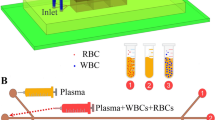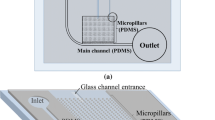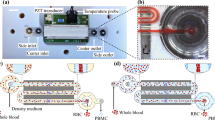Abstract
This paper presents a microfluidic chip for highly efficient separation of red blood cells (RBCs) from whole blood on the basis of their native magnetic properties. The glass chip was fabricated by photolithography and thermal bonding. It consisted of one inlet and three outlets, and a nickel wire of 69-μm diameter was positioned in the center of a separation channel with 149-μm top width and 73-μm depth by two parallel ridges (about 10 μm high). The two ridges were formed simultaneously during the wet etching of the channels. The nickel wire for generating the magnetic gradient inside the separation channel was introduced from the side of the chip through a guide channel. The external magnetic field was applied by a permanent magnet of 0.3 T placed by the side of the chip and parallel to the main separation channel. The RBCs were separated continuously from the 1:40 (v/v) diluted blood sample at a flow rate in the range 0.12–0.92 μL/min (9–74 mm/min) with the chip, and up to 93.7% of the RBCs were collected in the middle outlet under a flow rate of 0.23 μL/min. The cell sedimentation was alleviated by adjusting the specific density of the supporting media with bovine serum albumin. Quantum dot labeling was introduced for visual fluorescence tracking of the separation process. The uneven distribution phenomenon of the blood cells around the nickel wire was reported and discussed.

Glass chip with single Ni wire aligned in the microchannel for continuous magnetic separation of blood cells






Similar content being viewed by others
References
Takayasu M, Kelland DR, Minervini JV, Friedlaender FJ, Ash SR (1999) Paper presented at IWCPB-HMF (international workshop on chemical, physical and biological processes under high magnetic fields), Omiya, Saitame, Japan, 24–26 November
Han KH, Frazier AB (2006) Lab Chip 6:265–273
Melville D, Paul F, Roath S (1975) Nature 255:706
Owen CS (1978) Biophys J 22:171–178
Takayasu M, Duske N, Ash SR, Friedlaender FJ (1982) IEEE Trans Magn Mag 18(6):1520
Takayasu M, Kelland DR, Minevini JV (1999) Paper presented at 16th international conference on magnet technology, Florida, USA, 26 September-2 October
Zborowski M, Ostera GR, Moore LR, Milliron S, Chalmers JJ, Schechter AN (2003) Biophys J 84:2638–2645
Han KH, Frazier AB (2005) NSTI-Nanotech 1:187–190
Han KH, Frazier AB (2004) J Appl Phys 96:5797–5802
Yi CQ, Li CW, Ji SL, Yang MS (2006) Anal Chim Acta 560:1–23
Li XJ, Li PCH (2005) Anal Chem 77:4315–4322
Yang MS, Li CW, Yang J (2002) Anal Chem 74:3991–4001
Furdui VI, Harrison DJ (2004) Lab Chip 4:614–618
Grodzinski P, Yang J, Liu RH, Ward MD (2003) Biomed Microdevices 5:303–310
Inglis DW, Riehn R, Austin RH, Sturm JC (2004) Appl Phys Lett 85:5093–5095
Enger J, Goksor M, Ramser K, Hagberg P, Hanstorp D (2004) Lab Chip 4:196–200
Chiou PY, Ohta AT, Wu MC (2005) Nature 436:370–372
Brody JP, Osborn TD, Forster FK, Yager P (1996) Sens Actuators A 54:704–708
Crowley TA, Pizziconi V (2005) Lab Chip 5:922–929
Chen X, Cui DF, Liu CC, Li H Sens (2007) Sens Actuators B. doi:10.1016/j.snb.2007.07.126
Chou C, Morgan M, Zenhausern F, Prinz C, Austin R (2002) MicroTAS 25–27
Durr M, Kentsch J, Muller T, Schnelle T, Stelzle M (2003) Electrophoresis 24:722–731
Huang Y, Joo S, Duhon M, Heller M, Wallace B, Xu X (2002) Anal Chem 74:3362–3371
Gill R, Freeman R, Xu JP, Willner I, Wingograd S, Shweky I, Banin U (2006) J Am Chem Soc 128:15376–15377
Wu SM, Zhao X, Zhang ZL, Xie HY, Tian ZQ (2006) Chemphyschem 7:1062–1067
Jiang C, Xu SK, Yang DZ, Zhang FH, Wang WX (2007) Luminescence 22:430–437
Xie M, Liu HH, Chen P, Zhang ZL, Wang XH, Xie ZX, Du YM, Pan BQ, Pang DW (2005) Chem Commun 44:5518–5520
Jaiswal JK, Simon SM (2004) Trends Cell Biol 14:497–504
Fang F, Wu ZY (2006) Chin Patent Appl 200610047737.4
Yin XF, Shen H, Fang ZL (2003) Chin J Anal Chem 31:116–119
Fang DF, Zhou L, Ding L, Zhang DC (1995) Modern medicinal research technology manual. Union Press of Peking University of Medical Science and Peking Union Medical College, Beijing
Chen QF, Wang WX, Ge YX, Xu SK, Yang DZ (2007) Chin J Anal Lab 26:1–5
Moeser GD, Roach KA, Green WH, Hatton TA, Laibinis PE (2004) AIChE J 50:2835–2848
Qiu JC (1987) Mineral processing technology. Metallurgical Industry, Beijing
Charles N, Liesveld JL, King MR (2007) Biotechnol Prog 23:1463–1472
McCloskey KE, Chalmers JJ, Zborowski M (2003) Anal Chem 75:6868–6874
Kuhara M, Takeyama H, Tanaka T, Matsunaga T (2004) Anal Chem 76:6207–6213
Xie HY, Zuo C, Liu Y, Zhang ZL, Pang DW, Li XL, Gong JP (2005) Small 5:506–509
Wang GP, Song EQ, Xie HY, Zhang ZL, Tian ZQ, Zuo C, Pang DW, Wu DC, Shi YB (2005) Chem Commun 34:4276–4278
Liu YJ, Guo SS, Zhang ZL, Huang WH, Baigl D, Xie M, Chen Y, Pang DW (2007) Electrophoresis 28:4713–4722
Acknowledgements
Financial support from Northeastern University is acknowledged. The authors are grateful to Hong-Zhuan Yin from the Chinese Medicine University for fruitful discussions.
Author information
Authors and Affiliations
Corresponding author
Rights and permissions
About this article
Cite this article
Qu, BY., Wu, ZY., Fang, F. et al. A glass microfluidic chip for continuous blood cell sorting by a magnetic gradient without labeling. Anal Bioanal Chem 392, 1317–1324 (2008). https://doi.org/10.1007/s00216-008-2382-4
Received:
Revised:
Accepted:
Published:
Issue Date:
DOI: https://doi.org/10.1007/s00216-008-2382-4




